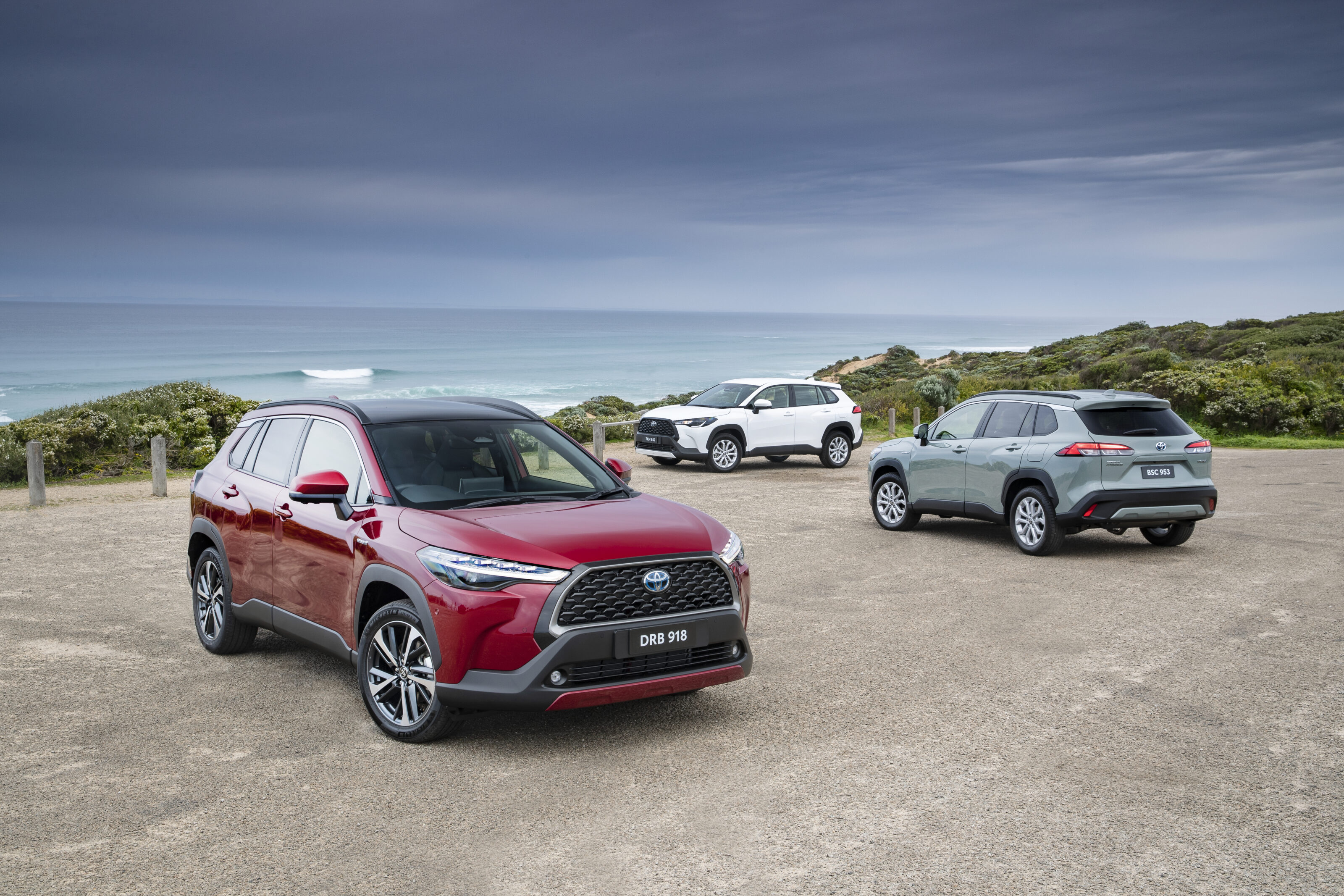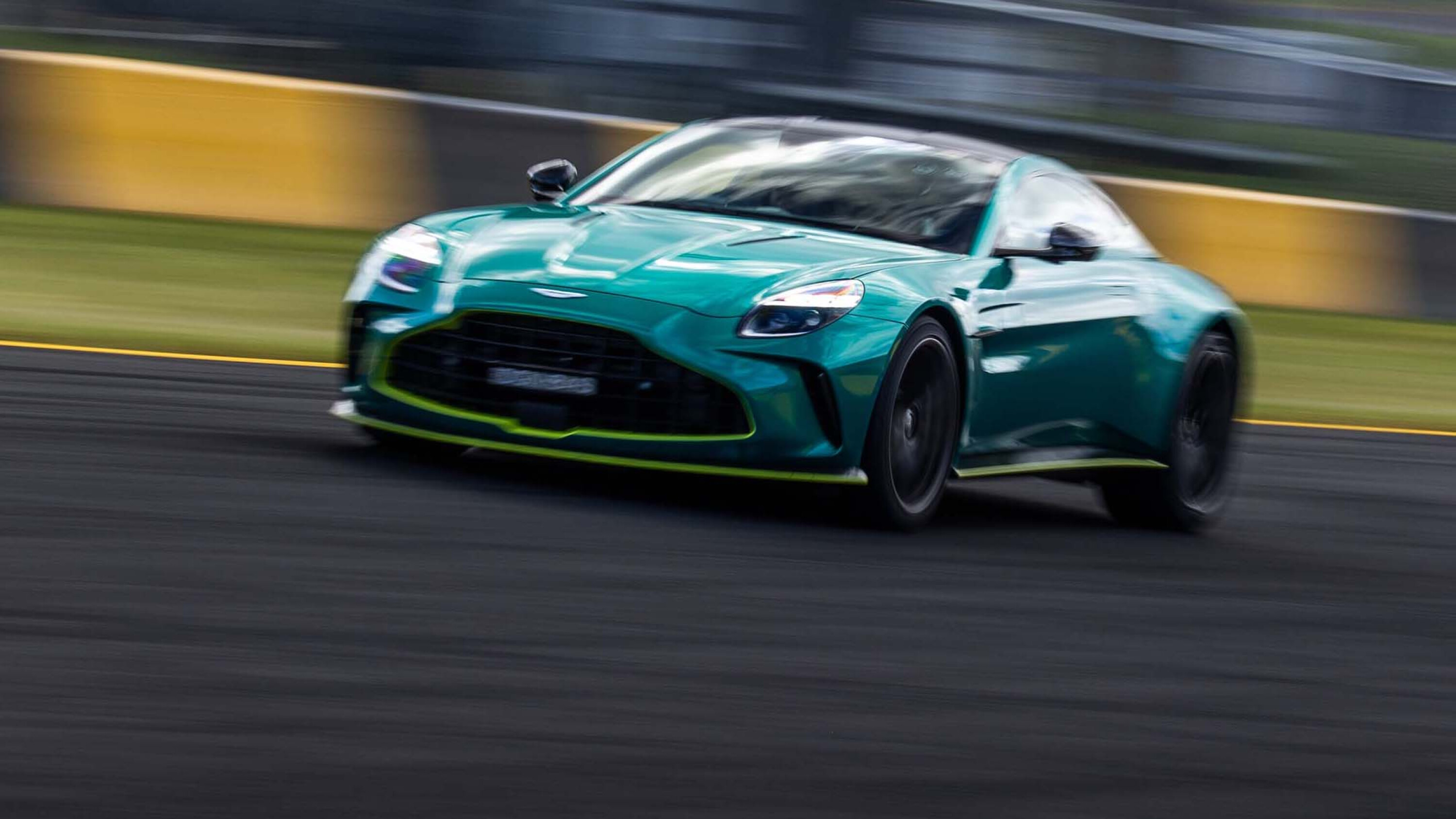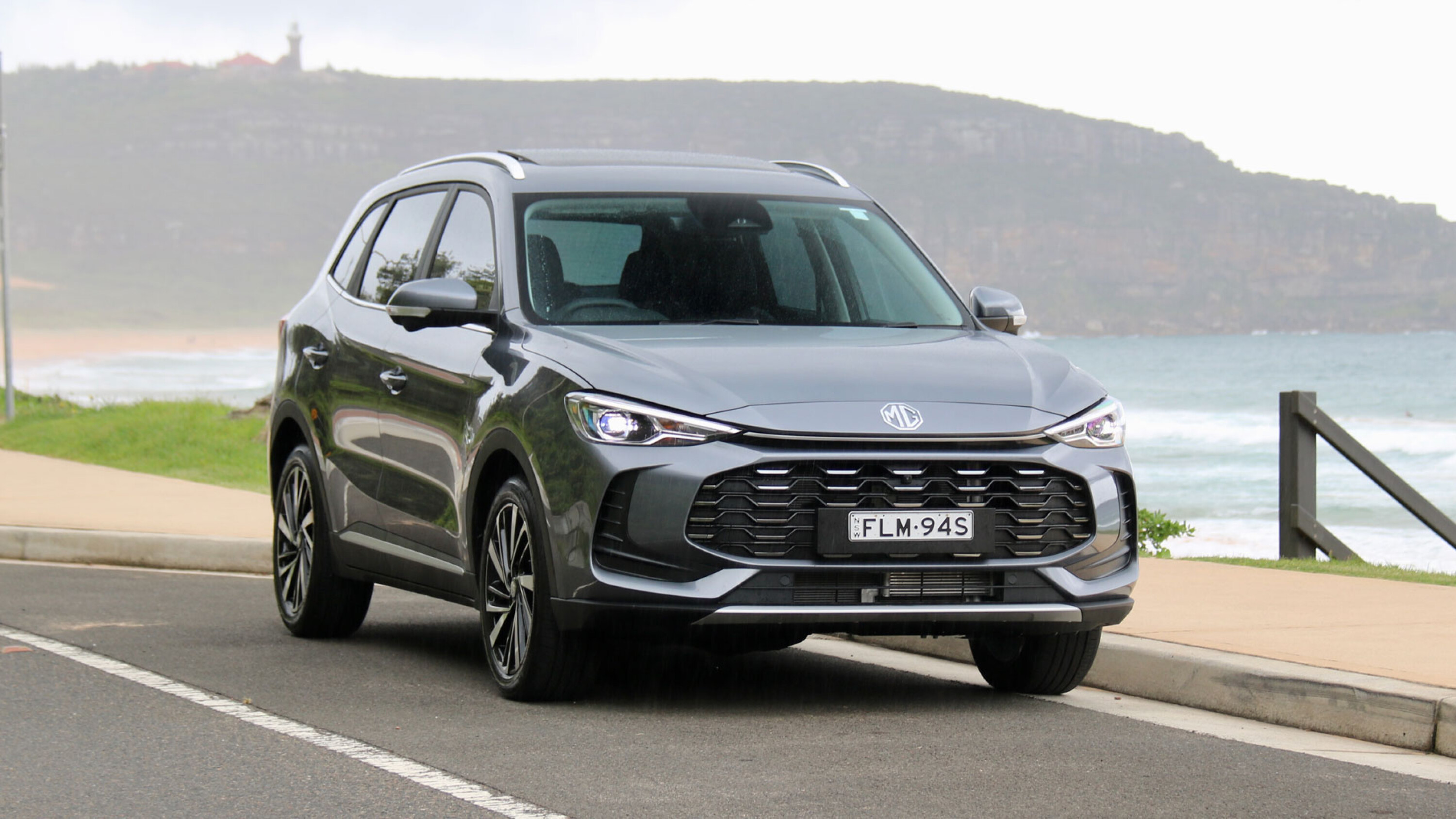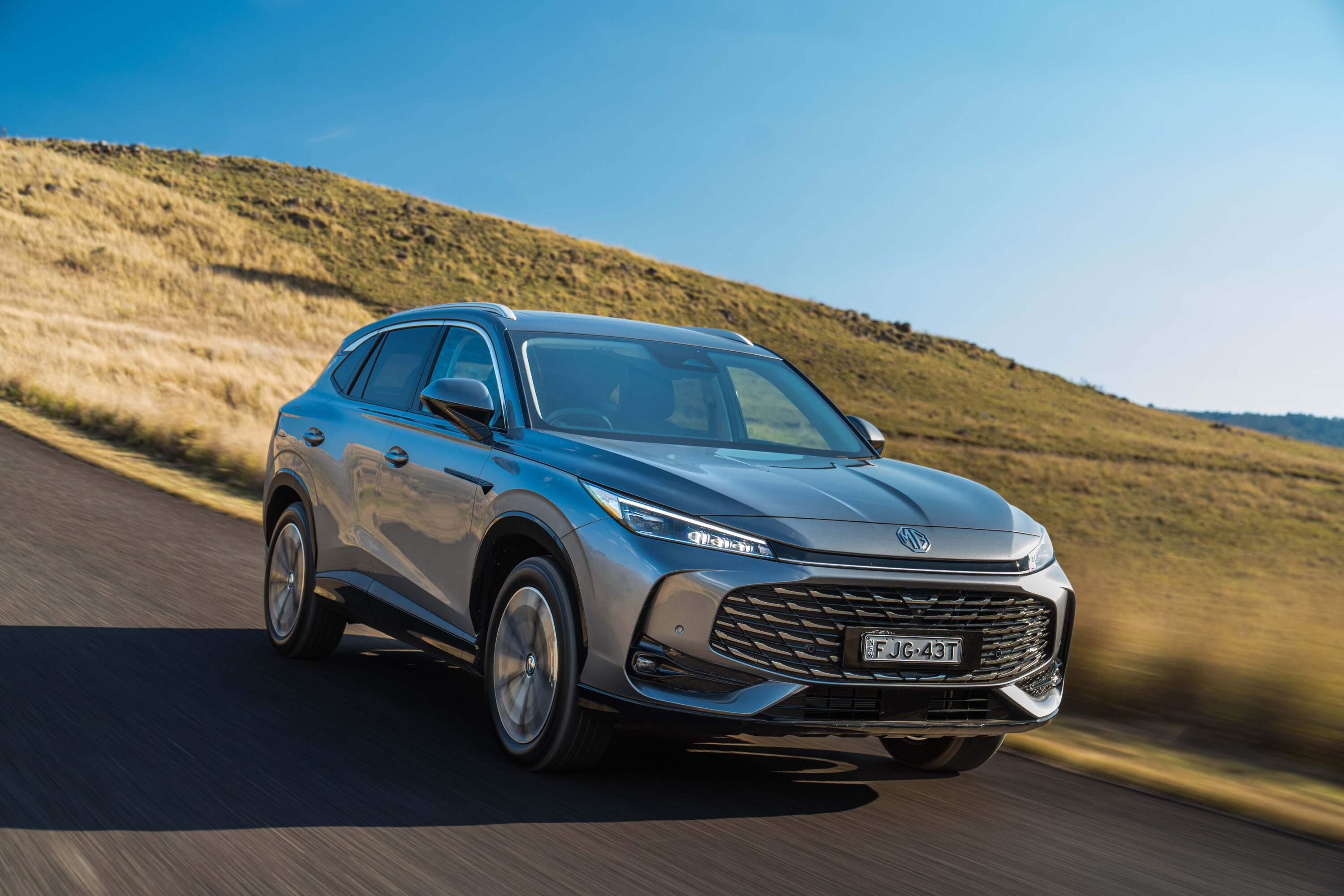Score breakdown
Things we like
- Powerful hybrid
- Compact body, spacious cabin
- Crisp steering response
- Cheap servicing
Not so much
- Cheap and nasty switchgear
- Laggy infotainment system
- Spongy brakes; oversensitive ABS
- FWD’s torsion beam lacks silky smoothness
Samuel Beckett wrote Waiting for Godot in 1953. The play has one set, and follows main characters Didi and Gogo as they circle aimlessly back and forth stuck waiting for a mystical character – Godot – who never arrives.
For some time, it felt like the Toyota Corolla Cross was the SUV-hungry public’s Godot. An idea so simple, and seemingly so easy to carry off, that even though Toyota (arguably) spearheaded the small SUV revolution in the mid-90s with its then-compact RAV4, the brand couldn’t see the wood for the trees.
Until September 2022, of course, when the Corolla Cross was finally released in Australia following years of speculation and patient waiting.

And it did so to critical acclaim, having skipping undefeated through two Wheels comparison tests already, as well as scoring high praise from punters with Toyota shifting 1814 units in two months on-sale despite well-documented supply challenges.
The Corolla Cross range is broad, with eight total permutations to choose from – the one in question being the second dearest Atmos front-wheel drive (FWD) hybrid that might just be the pick of the lineup.
Toyota Corolla Cross: The basics
| Feature | Corolla Cross Atmos hybrid FWD |
|---|---|
| Engine | 2.0-litre petrol + electric motor |
| Motors (F) | 83kW/206Nm |
| Power | 146kW |
| Torque | Not quoted |
| 0-100km/h | 7.7 seconds |
| Gearbox | eCVT auto |
| Body | 5 doors, 5 seats |
| Fuel/tank | 91 RON / 36 litres |
| Economy | 4.9L/100km (tested) |
| Boot space | 425L |

JUMP AHEAD
- How much is it, and what do you get?
- How do rivals compare on value?
- Interior comfort, space, and storage
- What is it like to drive?
- How safe is it?
- Warranty and running costs
- VERDICT
How much is it, and what do you get?
The Corolla Cross follows Toyota’s typical SUV naming structure: GX opener, mid-spec GXL and the range headlined by a more imaginative title – in this case, Atmos.
In Atmos front-drive hybrid trim, the Corolla Cross costs a steep $46,050 before on-road costs, and this example had Frosted White pearl paintwork ($575). The Atmos starts at $43,550 before on-road costs for the petrol and runs to $49,050 for the hybrid AWD.
The Atmos carries a significant upcharge of $6800 over a mid-spec GXL, and to distinguish it Toyota includes leather upholstery, power adjustment and heating for both front seats as well as the steering wheel – finally filling the egregious switch blanks of the base grades – and a 360-degree parking camera.

There is also a 12.3-inch digital driver’s display that can show navigation prompts, but not a full map. The graphics here are legible, if reserved in their design.
Toyota’s latest 10-inch infotainment touchscreen is a whole lot larger than the old item and has the ability to wirelessly mirror Apple CarPlay (but not Android Auto). Although the new interface looks far nicer, there isn’t a whole lot more capability from the touchscreen, with lots of sparse menu screens that look wasted.
Boot-up time also proved glacial, with the Corolla Cross taking 22 seconds before the touchscreen came fully responsive and allowed interacting with music, navigation and other services.

The Corolla Cross’s standard nine-speaker JBL sound system does a decent job of rendering sound, but lacks the power and clarity of the best systems such as the Mazda CX-30’s warm eight-speaker system.
The Atmos also includes connected services with smartphone unlock and remote engine start, as well as live navigation with voice activation for the first year as part of the purchase price.
It does become an ongoing cost, however, charged monthly at a rate of $9.95 for phone connectivity, and another $12.50 for the connected navigation services.

How do rivals compare on value?
The hybrid small SUV market is ramping up with the slick new Nissan Qashqai e-Power set to launch soon, a hybridised Hyundai Kona on the way, Subaru’s new Crosstrek hybrid here next year, and of course the Kia Niro hybrid and Honda HR-Vs that are already on sale.
As for pricing, the Corolla Cross – although far dearer than its hybrid ZR hatch counterpart ($39,120) – actually competes fairly well with other small SUVs.
A Nissan Qashqai Ti starts at $47,390, a Honda HR-V that makes do with (admittedly rather spiffy) manual adjust cloth-centred seats costs $47,000 (driveaway), while the Niro Hybrid GT-Line is a cut above all rivals for price (if not material quality) at $50,030 before on-road costs.
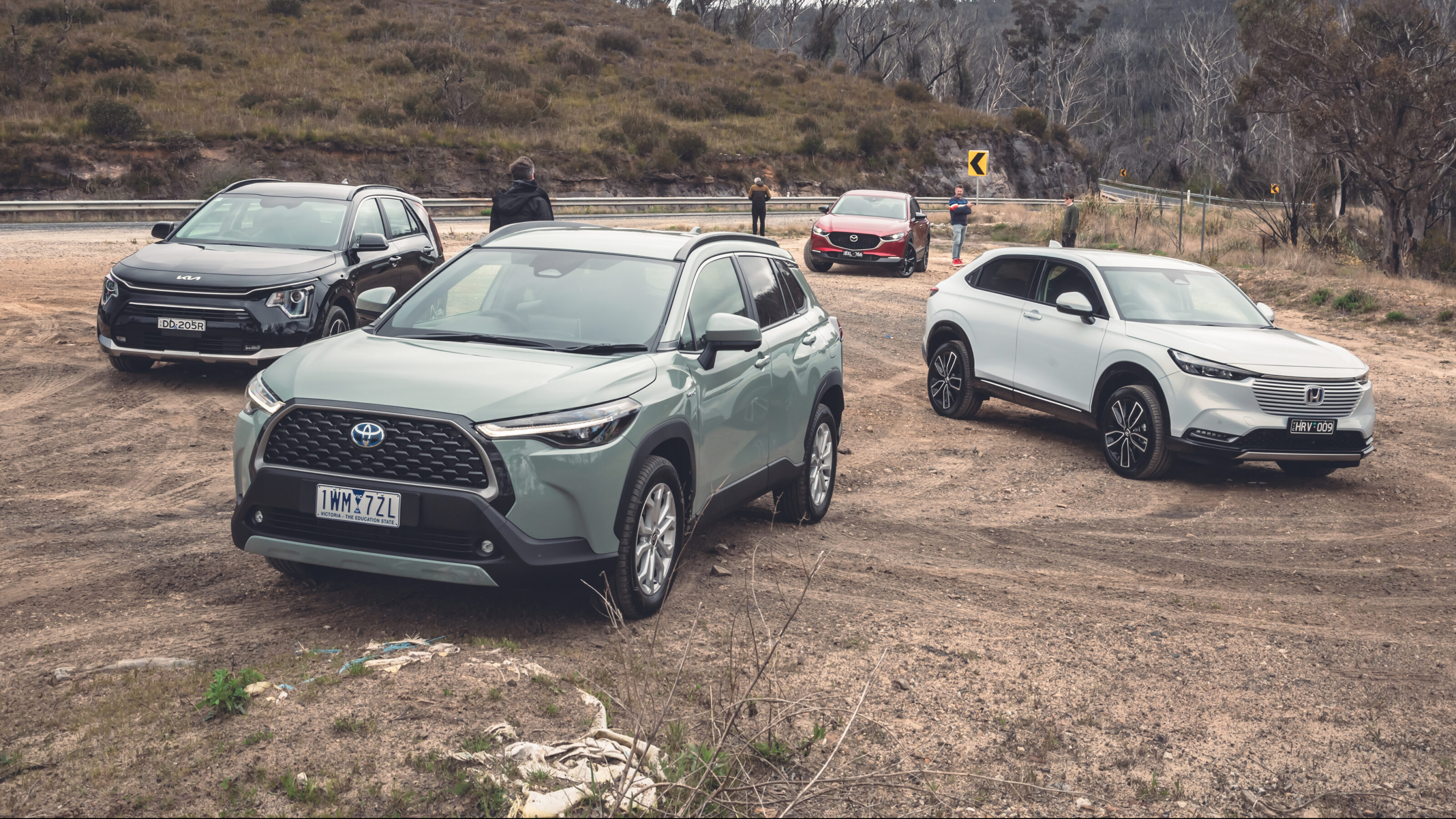
The other consideration is for a Toyota RAV4 which, in front-drive Cruiser hybrid trim with leather upholstery, nicer cabin materials and a good deal more space, costs a mere $2150 more than Corolla Cross.
Of course, if you’ve seen RAV4 wait times you might be thinking it’s worth it in time to go for the 140mm shorter and 30mm narrower Corolla Cross, but that isn’t necessarily the case as, although Toyota claimed ‘good stock’ of the smaller SUV at launch, its wait times didn’t take long at all to draw out. Contact your local dealer for more wait times info.

Interior comfort, space and storage
The Atmos’ spec sheet may read ‘leather appointed’ but the underside of my thighs found the Corolla Cross’s black upholstery to be rather sweat-inducing as Sydney’s countless months of rain made way for a humid summer.
It’s an unfortunate truth that, though the Corolla Cross Atmos generally lifts the interior ambience handily over the GXL, Toyota’s choice to give black upholstery without seat cooling is quite a miss. The Kia Seltos may have vinyl seats, but its three-stage ventilated chairs help to offset the summer stickiness.
If you aren’t a perspirer you might not find this an issue as the Corolla Cross’s seats are comfortable, with 8-way electric adjust for the driver including lumbar support helping to facilitate a better driving position than the GXL’s rudimentary manual sliders.

That said, it’s a tragedy Toyota perseveres with a non height-adjustable front passenger seat after the RAV4 copped so much criticism for the same issue. At 188cm tall I felt uncomfortably tall riding in the passenger seat.
Look around the Atmos’s cabin and perceived quality isn’t great, either. There’s a mile of scratchy plastic encasing the dashboard, even making its way to the fascia to the right of the driver.
The armrests are also appointed with a liquorice layer of black vinyl without any real padding so those with pointy elbows will quickly grow tired of arm-resting on longer drives.
Storage solutions are solid, with a decently-sized covered cubby between the front seats, door bins that fit a one-litre camping bottle and a pair of cup holders in the centre console.

Technology provisions, however, are not so good. The Atmos gets a wireless charging pad, but it’s hard plastic with an indent that isn’t big enough for a humble iPhone X, so under hard acceleration phones go sliding all over the shop.
The Corolla Cross also has only a single external USB-A charging point in the front seat, supplemented by a hidden 12-volt socket in the central bin.
This is especially peculiar, as in the back seat the Corolla Cross has a pair of fast-charging USB-C ports. Ostensibly, one could use a cable looped around from one of these into the front seat for added charging.
It’s actually the back seat where Corolla Cross is best thought out; a perfect family or ride-share vehicle with ample head-room, good knee-room and capacious space for toes.

There are adjustable air vents across the range, but no heating elements in the Atmos’s rear bench. At least the black upholstery will be easy to clean, and although the door tops are hard in the back seat, that’s how it is (though not how it should be for $50K) in the small SUV class.
Finally, to the boot, and along with the back seat these are the real advantages the Cross brings over C-HR or Corolla hatch. With its generous power tailgate and low load-lip it’s easy to load bulky items into the Atmos hybrid’s 425L boot.
Under the floor there’s a space saver spare tyre as well, which is a nice touch. The back bench folds in a 60/40 configuration. With the second row folded there is a pronounced lip in the middle of the load space; not ideal for carrying push-bikes.
| Small SUV boot comparison | |
|---|---|
| Kia Seltos GT-Line | 433L |
| Haval Jolion | 430L |
| Toyota Corolla Cross Atmos | 425L |
| Nissan Qashqai Ti | 418L |
| Mitsubishi ASX | 393L |
| Volkswagen T-Roc 140TSI | 392L |
| MG ZS | 359L |
| Mazda CX-30 Astina | 317L |

What is it like to drive?
Hybrids are a luxury. Yes, a full EV is more silent, but at this price you’re not getting much of an electric vehicle, and the Corolla Cross does a top job masquerading as one on start-up, the digital cluster coming to life without any aural drama.
You can creep out of a roadside spot or driveway using the 83kW/206Nm electric front motor fitted to this FWD hybrid. Toyota’s fifth-gen hybrid system made its Australian debut in the Corolla Cross, with a 4.06Ah lithium-ion battery that improves response, power and step-off performance over the fourth-gen equipment.
Combined with a 2.0-litre Atkinson cycle petrol four-cylinder the Corolla Cross makes 146kW of power – right up there with a turbo-petrol rival such as the Volkswagen T-Roc 140TSI.

Although an AWD Corolla Cross is available for another $3000, the power level doesn’t increase, with a 30kW electric motor on the rear axle mainly for managing traction.
Being the plushest (and therefore heaviest trim in the range at 1480kg), the Atmos front-drive is the slowest Corolla Cross to crack the tonne, with Toyota claiming a 7.7 second sprint for the FWD hybrid.
In testing we were only able to manage an 8.0-second sprint. Regardless, the SUV is much faster than the circa-10-second hybrid hatch’s sprint.
A good steering system can really make a car, and the Corolla Cross has one. With 2.7 turns lock-to-lock it’s a pretty sharp rack for this kind of class. There’s a little bit of deadzone around the centre, but it’s well judged and makes the Cross feel calm at high speeds.

Thumb the drive mode button to Sport and the weight increases to add more confidence to the Corolla Cross’s front end. Once into the meat of the electrically-assisted steering it weights up and, although there’s not any granular feel, the tiller does communicate something, and is more consistent than a Mazda CX-30’s rack.
And then with the car in a corner it’s immensely talented. The Atmos’ 225/50 R18 Michelin Primacy tyres add an extra layer of talent to the TNGA-C platform over the GXL and GX’s vocal eco rubber.
While handling isn’t the defining yardstick of a small SUV, when a vehicle has great road-holding and an engaging drive, it deserves praise.
It’s a bit of a miracle that the Corolla Cross feels so well put together on road, as the brake feel seems to do everything it can to erode confidence. The swap over from regen-physical braking force feels amateur, with a squelchy pedal and distinct changeover point.

Part of the unpleasant braking seems to be the Corolla Cross’s significant pitch under brakes that unweights the rear axle and then causes ABS to trigger over bumps even under light brake pressure.
And while the ride loses some of the silky smoothness of the AWD’s multi-link rear end in the FWD Atmos – it’s a shame when a car costs so much more than the hatch it’s based on yet you lose a key selling point – the Atmos is still a plush SUV.
Part of that pitch under braking is that the Corolla Cross’s soft springs let the dampers move fluidly through their full motion, cushioning rides from big hits and low-speed chatter.
The Corolla Cross is an exceptionally comfortable small SUV that handles surprisingly well, but the oddities including the brake feel and vertical pitch come uncomfortably close to spoiling the Corolla Cross’s engineering excellence.

How much fuel does it use?
Toyota’s hybrid tech is bang on the money. Aside from the Nutribullet-esque combustion engine, the system is seamless in its latest form.
If the petrol engine was more refined, one would be blissfully unaware that it even existed, such is the advancement of the power-source blending.
This, naturally, bolsters fuel economy with an ADR 81/02 rating of 4.3L/100km for the front-drive models.

During our week we recorded 4.9L/100km on the trip computer, but driven carefully around town you could match the book figure with little difficulty.
The hybrid Corolla Cross saves petrol at a rough rate of 30 per cent compared to a similarly-quick turbo-petrol SUV such as a Volkswagen T-Roc 110TSI or Nissan Qashqai.
If driven an average annual distance of 13,000km, a hybrid Corolla Cross would save around $400/year in petrol costs. It will also take 91 RON or an E10 blend at the bowser.

How safe is it?
The Toyota Corolla Cross was awarded five stars in ANCAP safety testing conducted in 2022
Aside from that dodgy ABS tune, the Cross’s basic passive safety aspects, such as steadfast road-holding, seven airbags and quality tyres matched with excellent forward and side visibility give a great platform to work off, too.
Toyota has advanced its lane-keep assist and adaptive cruise control tuning for the Corolla Cross and it makes the system far more usable than in the hatch, but it still ping-pongs between lane markings and slows down too early in response to a car in front for our liking.

Further must-have safety features fitted to the Corolla Cross Atmos include forward AEB with pedestrian, cyclist and junction detection, low-speed reverse AEB, blind-spot monitoring, rear cross-traffic alert with brake and traffic-sign recognition.
Other little things in the Cross have improved as well, such as the sound quality of chimes. The parking sensors no longer trill such a shrill warning as in prior Toyota products, instead the sounds have been rounded off a little, giving Corolla Cross an extra air of quality.

Warranty and running costs
Toyota caps service pricing for the Corolla Cross at $230 per visit for the first five years. Maintenance is due every 12 months or 15,000kms.
Few rivals are cheaper, except the Honda HR-V (even after a recent price hike), which costs $199 per service, though it can only travel 12 months/10,000kms between trips to the dealer. The same is true of the Kia Seltos AWD, which costs an average of $404 per service over five years.
The Seltos does kick back with a seven-year, unlimited kilometre warranty in Australia, while Mitsubishi offers a 10-year/200,000km guarantee on the ASX, providing it is serviced on time at a dealership.
Toyota has stuck to an industry-standard five-year, unlimited kilometre warranty for the Corolla Cross in Australia.

VERDICT
Was it worth waiting for Godot in the end? The Toyota Corolla Cross doesn’t push the game forward – it feels as though Toyota benchmarked the best-in-class, got mostly there, and deemed that adequate.
Aside from its powertrain, the Corolla Cross doesn’t excite, not with its styling or rather nasty cabin appointments. There are a few glaring faults we’d love to see fixed as well, such as the brake feel and ABS tune.
And yet, it’s still worth strongly considering the Corolla Cross – almost to the point of writing off its rivals – as, despite shortcomings, it manages to be an excellent small SUV with low running costs, startlingly strong fuel efficiency, comfortable suspension and great road-holding.
The Atmos variant is far more complete than GXL, and unless you’re chasing the silky smooth ride from independent rear suspension and 10 per cent better grip on loose surfaces, then we think the front-drive hybrid is the buy with that extra $3K left lining your pockets.
Toyota Corolla Cross specifications
| Feature | Corolla Cross Atmos hybrid FWD |
|---|---|
| Engine | 2.0L DOHC 16V Atkinson cycle |
| Motors (F) | 83kW/206Nm |
| Power | 146kW |
| Torque | Not quoted |
| 0-100km/h | 7.7 seconds |
| Gearbox | eCVT |
| Body | steel, 5 doors, 5 seats |
| L/W/H/Wu2013B | 4460/1825/1620/2640mm |
| Track (F/R) | 1570/1580mm |
| Ground clearance | 160mm |
| Boot space | 425L (other models 380-436L) |
| Weight | 1480kg |
| Fuel/tank | 91 RON / 36 litres |
| Economy | 4.9L/100km (tested) |
| Suspension | Front: struts, coil springs, anti-roll bar. Rear: torsion beam |
| Steering | electric rack-and-pinion; 2.76L-L; 10.4M |
| Front brakes | ventilated discs (305mm) |
| Rear brakes | Solid discs (281mm) |
| Tyres | Michelin Primacy |
| Tyre size | 225/50R18, space-saver spare |
Score breakdown
Things we like
- Powerful hybrid
- Compact body, spacious cabin
- Crisp steering response
- Cheap servicing
Not so much
- Cheap and nasty switchgear
- Laggy infotainment system
- Spongy brakes; oversensitive ABS
- FWD’s torsion beam lacks silky smoothness
We recommend
-
 News
News2023 Toyota Corolla Cross pricing and features
Toyota's new small SUV, the Corolla Cross, has landed in Australia, slotting between the Yaris Cross and RAV4
-
 Reviews
Reviews2023 Toyota Corolla Cross review: Australian launch
The Corolla Cross mates the hatch’s frugal hybrid and TNGA-C platform with a small SUV form factor, so it should be a screaming success
-
 News
News2025 New Car Calendar: All the new cars coming to Australia
Take a look at our list of what is expected to launch in Australia in 2025 – plus those we might not see locally just yet




